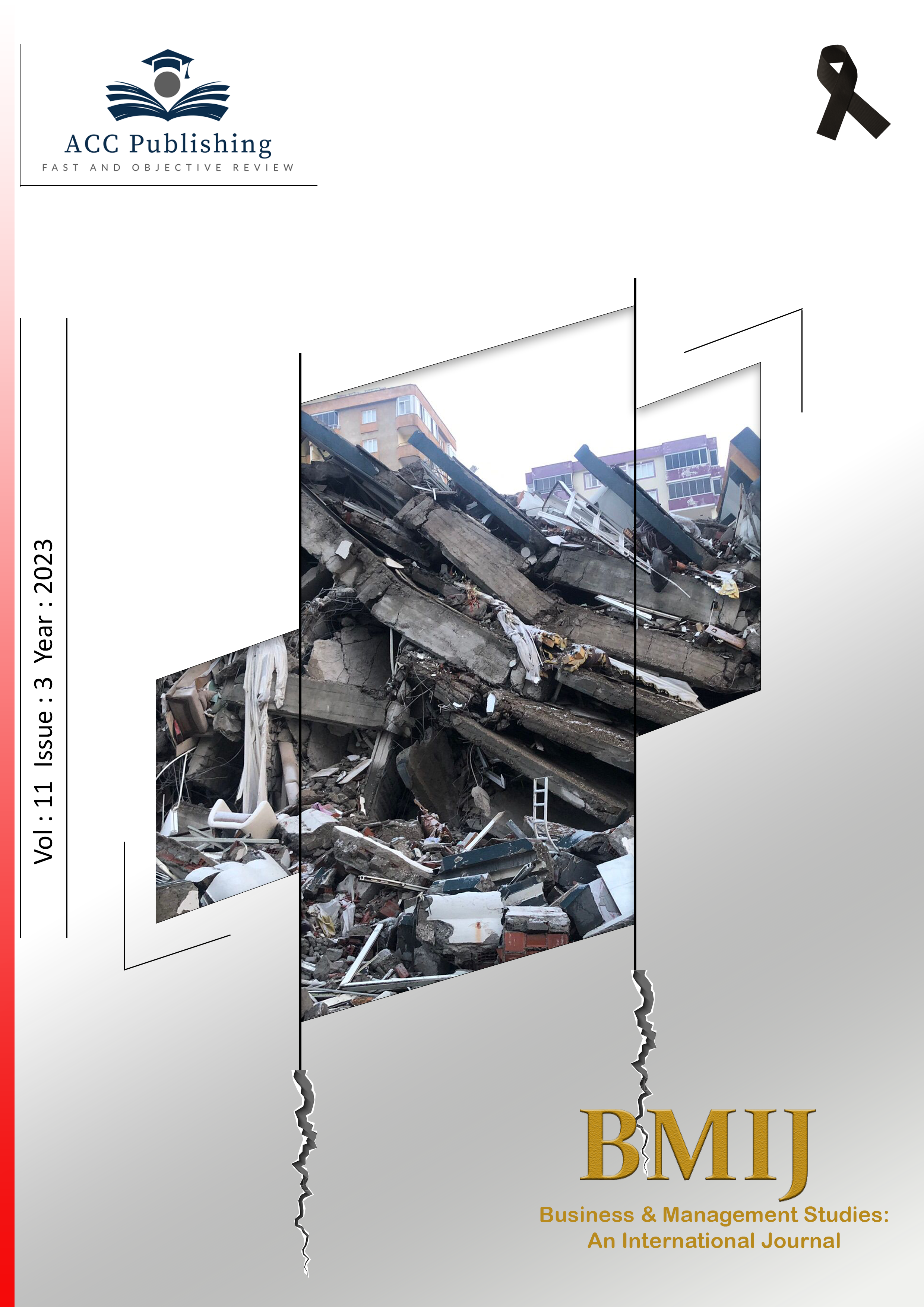
Yayınlanmış 24.09.2023
Anahtar Kelimeler
- Advertising Intensity, Dorfman-Steiner Condition, Inverted-U Hypothesis, Market Concentration, Profitability
- Reklam Yoğunluğu, Dorfman-Steiner Koşulu, Ters-U Hipotezi, Piyasa Yoğunlaşması, Kârlılık
Nasıl Atıf Yapılır
Telif Hakkı (c) 2023 Ömer Yurtseven- Burak Günalp

Bu çalışma Creative Commons Attribution-NonCommercial-NoDerivatives 4.0 International License ile lisanslanmıştır.
Nasıl Atıf Yapılır
Öz
Bu çalışmada 66 dört haneli Türk imalat endüstrisi için 1993–1999 dönemine ait panel veriler kullanılarak reklam yoğunluğunun belirleyenleri araştırılmaktadır. Havuzlanmış en küçük kareler ve sabit etkiler regresyonlarından elde edilen sonuçlar reklam yoğunluğu ile yoğunlaşma arasında bir kuadratik ilişkinin varlığını ortaya koymuştur: Reklam yoğunluğu yoğunlaşma oranı ile birlikte önce artmakta, yoğunlaşma oranı belli bir eşik değerin üzerine çıktığında yoğunlaşma oranındaki artışlar reklam yoğunluğunu azalmaktadır. Sonuçlar ayrıca, daha kârlı ve daha hızlı büyüyen endüstrilerin daha yoğun reklam verdiğini göstermiştir. Ürün dayanıklılığı, ihracat yoğunluğu ve tüketim malları satışı reklam yoğunluğunu etkileyen diğer faktörler olarak görünmektedir. Ancak, bu faktörlere ilişkin kanıtlar çok güçlü değildir.
Referanslar
- Bal, M. N. and Şengök, Z. N. (2003). Reklam ve piyasa yapısı, in İktisat seçme yazılar. Eds.: Yılmaz, Ş. and Çermikli, A. H. Ankara: Gazi Üniversitesi İİBF Yayını, 423-466.
- Breusch, T. and Pagan, A. (1980). The Lagrange multiplier test and its applications to model specification in econometrics. The Review of Economic Studies, 47(1), Econometrics Issue, 239-253.
- Brush, B. C. (1976). The influence of market structure on industry advertising intensity, Journal of Industrial Economics, 25(1), 55-67.
- Caves, R. E., Porter, M. E., Spence, A. M. and Scott, J. T. (1980). Competition in the open economy: A model applied to Canada. Cambridge, MA: Harvard University Press.
- Cable, J. (1972). Market structure, advertising policy and intermarket differences in advertising intensity. in Market structure and corporate behavior. Ed.: K. Cowling. London, Great Britain: Gray-Mills Publishing Ltd., 105-124.
- Chen, J. and Waters, G. (2017). Firm efficiency, advertising and profitability: theory and evidence, Quarterly Review of Economics and Finance, 63, 240–248.
- Coate, M. B. and Uri, N. D. (1986). A simultaneous equations model of profitability, concentration and marketing expense, Journal of Behavioral Economics, 12, 1-15.
- Collins, N. R. and Preston, L. E. (1968). Concentration and price-cost margins in manufacturing industries. Berkeley, CA: University of California Press.
- Collins, N. R. and Preston, L. E. (1969). Price-cost margins and industry structure, Review of Economics and Statistics, 51(3), 271-286.
- Comanor, W. S. and Wilson, T. A. (1974). Advertising and market power. Cambridge, MA: Harvard University Press.
- Delorme, C. D., Kamerschen, D. R., Klein, P. G. and Voeks, L. F. (2002). Structure, conduct and performance: a simultaneous equations approach, Applied Economics, 35(1), 13-20.
- Dorfman, R. and Steiner, O. (1954). Optimal advertising and optimal quality, American Economic Review, 44(5), 826-836.
- Farber, S. (1981). Buyer market structure and R&D effort: a simultaneous equations model, Review of Economics and Statistics, 63(3), 336-345.
- Gisser, M. (1991). Advertising, concentration and profitability in manufacturing, Economic Inquiry, 29, 148-165.
- Greer, D.F. (1971). Advertising and market concentration, Southern Economic Journal, 38(1), 19-32.
- Günalp, B. (1997). A simultaneous equation analysis of market structure, conduct and performance: new evidence from the U.S. manufacturing industries. Unpublished Dissertation. Lubbock, Texas: Texas Tech University.
- Hay, D. A. and Morris, D. J. (1991). Industrial economics and organization: theory and evidence. New York, NY: Oxford University Press.
- Hausman, J. (1978). Specification tests in econometrics. Econometrica, 46(6), 1251-1271.
- Honda, Y. (1985). Testing the error components model with non-normal disturbances. The Review of Economic Studies, 52(4), 681-690.
- Jones, T. (2004). Business economics and managerial decision making. West Sussex, England: John Wiley & Sons.
- Lustgarten, S. H. (1975). The impact of buyer concentration in manufacturing industries, Review of Economics and Statistics, 57(2), 125-132.
- Martin, S. (1979a). Advertising, concentration, and profitability: the simultaneity problem, Bell Journal of Economics, 10(2), 639-647.
- Martin, S. (1979b). Entry barriers, concentration, and profits, Southern Economic Journal, 46(2), 471-488.
- Martin, S. (1993). Advanced industrial economics. Cambridge, MA: Blackwell Publishers.
- Nelson, P. (1970). Information and consumer behavior, Journal of Political Economy, 78(2), 311-329.
- Nelson, P. (1974). Advertising as information, Journal of Political Economy, 82(4), 729-754.
- Ornstein, S. I. (1976). The advertising-concentration controversy, Southern Economic Journal, 43(1), 892-902.
- Ornstein, S. I. (1977). Industrial concentration and advertising intensity. Washington, DC: American Enterprise Institute for Public Policy Research.
- Pagoulatos, E. and Sorensen, R. (1976). Foreign trade, concentration and profitability in open economies, European Economic Review, 8(3), 255-267.
- Resende, M. (2006). The determinants of advertising intensity in the Brazilian manufacturing industry: an econometric study, Nova Economia, 16(3), 407-422.
- Resende, M. (2007). Structure, conduct and performance: a simultaneous equations investigation for the Brazilian manufacturing industry, Applied Economics, 39(7), 937-942.
- Scherer, F. M. and Ross, D. (1990). Industrial market structure and economic performance. Boston, MA: Houghton Mifflin Company.
- Strickland, A. D. and Weiss, L. W. (1976). Advertising, concentration, and price-cost margins, Journal of Political Economy, 84(5), 1109-1122.
- Sutton, C. J. (1974). Advertising, concentration and competition, Economic Journal, 84(333), 56-69.
- Uri, N. D. (1988). A re-examination of the relationship between industry structure and economic performance, Applied Economics, 20, 1383-1400.
- Wang, T. and Gambaro, M. (2019) The relationship between advertising and consumption. https://ssrn.com/abstract=3400495. Access Date: 06.08.2023.
- Waterson, M. (1984). Economic theory of the industry. New York, NY: Cambridge University Press.
- Weiss, L. W. (1976). Optimal plant size and the extent of sub-optimal capacity, in Essays on industrial economics in honor of Joe S. Bain. Eds.: R. T. Masson and P. D. Qualls. Cambridge, Mass.: Ballinger Publishing Company, 123-142.



